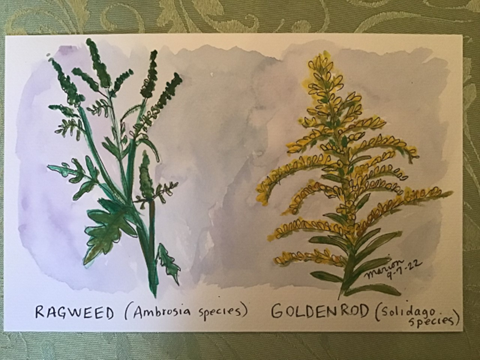Posted: November 3, 2022
Achoo! Who is to blame? Goldenrod or ragweed?

Drawing by Marion Barnes, Master Gardener
Seasonal allergies are no fun. During the fall months, certain plants are often blamed for sneezes, runny noses, and itchy eyes.
There are two similar plants that grow and bloom at this time of year, namely goldenrod, Solidago, or ragweed, Ambrosia. Both plants can be observed growing in open fields and along roadsides. Each are members of the Asteraceae family and are invasive plants. The two are flowering plants that can reach growth heights of 3 to 4 feet. Though much the characteristics, these plants have some major differences.
As the name suggests, goldenrod has showy gold-colored flowers. Its leaves have smooth margins. Goldenrod is an important source of nectar and pollen for bees, butterflies, and other pollinators. The pollen on a goldenrod is large and heavy. The pollen does not fall from the plant and requires the help of pollinators to survive.
Ragweed has green flowers and lobed leaves. It does not offer nectar, and relies on the wind to disperse its lightweight pollen from plant to plant. Ragweed produces massive amounts of tiny, breathable pollen that has the ability to blow for miles. A single ragweed plant can produce over a billion pollen grains! It is here we find the culprit of our sneezes. Ragweed can be a cause of seasonal allergies.
So, please do not blame goldenrod for allergy discomforts. Instead, remember to admire its beauty and benefit to the pollinators of Pennsylvania. As for ragweed, grab the tissues!
By Marion Barnes, Master Gardener
Source
Clemson University: How to tell the difference between goldenrod and ragweed

